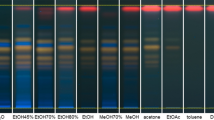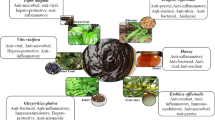Abstract
The genus Justicia (Acanthaceae) is a source of important pharmaceutical compounds. Justicia species are integral parts of several drug preparations in Indian indigenous healthcare system. However, J. beddomei and J. adhatoda are the authentic sources of ‘Vasa’. To authenticate assured therapeutic effect, proper identification at species level is critical. Phytochemical studies were carried out in different parts of seven Justicia species, viz., J. adhatoda, J. beddomei, J. betonica, J. carnea, J. gendarussa, J. santapaui and J. wynaadensis, using chromatographic analysis. Extracts of various parts like root, stem and leaf of the selected species were compared. The various parts showed remarkable differents in their chemical profiles. Comparative high-performance thin-layer chromatography (HPTLC) profile of seven Justicia species, various parts such as root, stem and leaf, have been developed and the same can be used as an analytical tool for the identification and authentication of genuine material and also as a ready reckoner to identify the authenticity of market raw drug samples.













Similar content being viewed by others
References
Durkee LH (1986) Flora Costaricensis: Acanthaceae. Fieldiana Bot 18:1–87
Mabberley DJ (2008) Mabberley’s plant book: a portable dictionary of plants, their classification and uses, 3rd edn. Cambridge University Press, New York, NY, pp 1021
Karthikeyan A, Shanti VM, Nagasathya A (2009) A preliminary phytochemical and antibacterial screening of crude extract of the leaf of Adhatoda vasica L. Int J Green Pharm 3:78–80
Sunil CN, Prabhukumar KM, Naveen Kumar VV, Hareesh VS, Baiju EC (2015) A striking species of Justicia species L. (Acanthaceae) from Western Ghats of India. Kew Bull 70:1–6
Corrêa GM, Alcântara AFDC (2012) Chemical constituents and biological activities of species of Justicia: a review. Rev Bras Farmacogn 22:220–238
Chattopadhyay N, Nosál’ová G, Saha S, Bandyopadhyay SS, Flešková D, Ray B (2011) Structural features and antitussive activity of water extracted polysaccharide from Adhatoda vasica. Carbohydr Polym 83:1970–1974
Subhashini S, Arunachalam KD (2011) Investigations on the phytochemical activities and wound healing properties of Adhatoda vasica leave in Swiss albino mice. Afr J Plant Sci 5:133–145
Suresh J, Muhameead RK, Hamath K, Nileena F, Rosemery K, Sinju PR, Nobin CJ (2019) Phytochemical screening of Justicia gendarussa. Int J Pharmacogn Chin Med 3:155
Sini S, Prashy P, George S (2018) Preliminary phytochemical investigation and estimation of polyphenolics in different parts of selected species of Justicia. Eur J Biomed Pharm Sci 5:460–464
Faiza R, Waqas KK, Adeel M, Muhammad G (2013) Detection of bioactive fractions of Justicia adhatoda leaves. Can J Appl Sci 1:388–398
Anonymous (2004) The ayurvedic pharmacopoeia of India (API). Part II, volume IV. Government of India, Ministry of Ayush. Pharmacopoeia Commission for Indian Medicine and Homeopathy, Ghaziabad
Warrier PK, Nambiar VP, Ramankutty C (1993) Indian Medicinal Plants. III. Orient Longman Ltd., Chennai, pp 272–273
Prabhukumar KM, Beegam F, George S (2018) Revisiting the taxonomy of Justicia beddomei (Acanthaceae). Phytotaxa 350:71
Gulfraz M, Arshad M, Nayyer N, Kanwal N, Nisar U (2004) Investigation of bioactive compounds of Berberis lycium Royle and Justicia adhatoda L. Ethanobot Leaflets 1:51–62
Anyakora C, Afolami I, EhianetaT Onwumere F (2008) HPLC analysis of nicotinamide, pyridoxine, riboflavin and thiamin in some selected food products in Nigeria. Afr J Pharm Pharmacol 2:029–036
Soni K, Naved T (2010) HPTLC: its applications in herbal drug industry. Pharmacol Rev 4:112–117
Sonal P, Maitreyi Z (2011) Pharmacognostic study of the root of Justicia gendarussa Burm. Asian J Trad Med 6:61–72
Suthar AC, Katkar KV, Patil PS, Hamarpurkar PD, Mridula G, Naik VR, Mundada GR, Chouhan VS (2009) Quantitative estimation of vasicine and vasicinone in Adhatoda vasica by HPTLC. J Pharm Res 2:1893–1899
Nikam PH, Kareparamban J, Jadhav A, Kadam V (2012) Future trends in standardization of herbal drugs. J Appl Pharm Sci 2:38–44
Author information
Authors and Affiliations
Corresponding author
Rights and permissions
About this article
Cite this article
Sini, S., George, S. HPTLC-based chromatographic studies in selected Justicia species for quality assessment. JPC-J Planar Chromat 33, 547–565 (2020). https://doi.org/10.1007/s00764-020-00076-3
Received:
Accepted:
Published:
Issue Date:
DOI: https://doi.org/10.1007/s00764-020-00076-3




